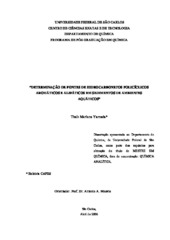Determinação de fontes de hidrocarbonetos policíclicos aromáticos e alifáticos em sedimentos de ambientes aquáticos
Abstract
Numerical values of polycyclic aromatic hydrocabons and n-alkanes distribution indexes of
sediments are important tools to elucidate the origins of hydrocarbons mixtures. Polycyclic
aromatic ratios are sensitive indicators of petrogenic and pyrogenic inputs, while n-alkanes
distribution usualy discriminates biogenic from petrogenic sources. The study area of this
work includes the Ibirité Reservoir and it´s tributaries, located in the Belo Horizonte
metropolitan area, a site strongly affected by a petroleum refinary from Petrobras, but where
an important industrial park is also present. Sampling was carried out in November 2005, at
12 stations located on Ibirité Reservoir, Pintados and Ibirité streams. The sediment samples
were extracted in ultrasonic bath, purified in chromatographic columns and analysed by
GC/MS. The studied compounds were polycyclic aromatic hydrocarbons, normal and
isoprenoids alkanes. The total concentrations varied from 33.66 to 772.61 ng g-1. Despite of
these low concentration values as compared to other aquatic environment, the Ibirité
Reservoir showed strong inflluence from anthropic activities, reflected on petrogenic and
pyrogenic hydrocarbons mixtures. The biogenic hydrocarbons, mainly derived from aquatic
and terretrial higher plants, also showed its contribution as a result of algal blooms and
extensive aquatic macrophyte banks typically found in the reservoir. Besides, the presence of
unresolved complex mixtures in all chromatograms, points out to a significant contribution of
petrogenic sources. Contamination of some sediment sample detectect in this study by
polycyclic aromatic hydrocarbons migth suggest that occasional adverse effects to the
organisms in this water body may occur. The sampling station of Taboões I stream was the
only one site that petrogenic controbuition was not detected. However, the site that was
considered as a reference site, showed that it suffers, already, influences from burned fossil
fuel from industries and automobiles from the nearby Belo Horizonte metropolitan area.
